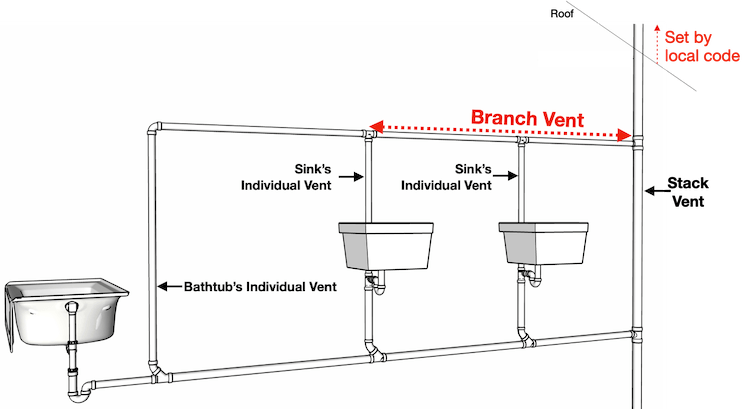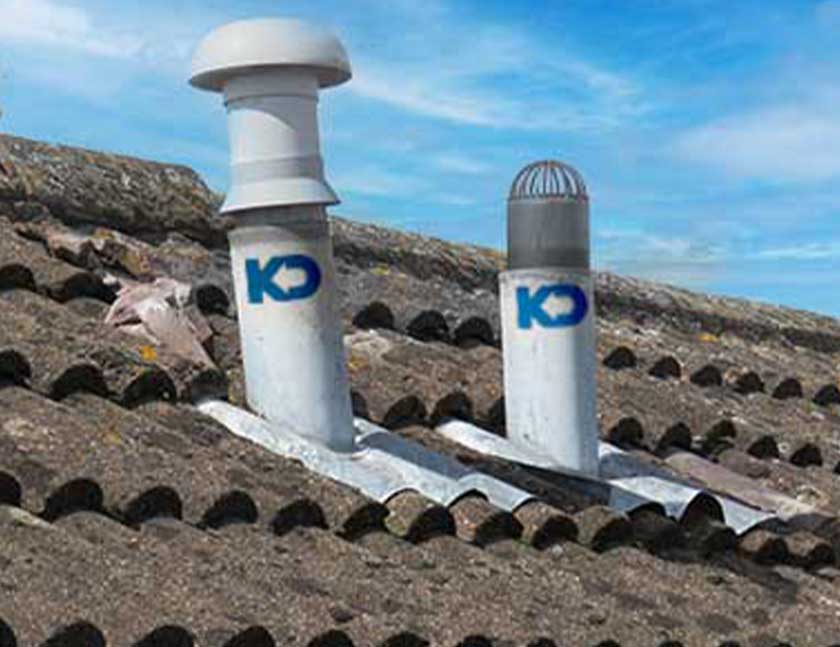Why Proper Ventilation in Plumbing Systems
Why Proper Ventilation in Plumbing Systems
Blog Article
How do you feel when it comes to Essential Plumbing Vent Pipes: Understanding Their Role?

Appropriate air flow in plumbing systems is frequently neglected, yet it is crucial for maintaining the capability and safety and security of your home's plumbing. Ventilation aids manage air pressure, prevent the accumulation of hazardous gases, and make sure the efficient elimination of waste. In this guide, we will discover the significance of proper pipes air flow, just how it works, and the benefits it gives your plumbing system.
Recognizing Ventilation in Pipes
Air flow in pipes refers to the network of pipelines that allow air to move with the drain system. These vents serve multiple functions, consisting of managing air pressure within the pipes, avoiding sewage system gases from entering the home, and helping in the smooth circulation of wastewater.
Exactly How Ventilation Works in Pipes Solutions
Air Pressure Law
Proper air flow preserves balanced atmospheric pressure within the pipes system. When water flows via pipes, it displaces air. Without appropriate air flow, this variation can produce negative stress, resulting in slow drains pipes or siphoning of water from traps, which can trigger unpleasant smells to leak into the home.
Avoiding Drain Gas Buildup
One of the most essential features of plumbing vents is to avoid sewer gases, such as methane and hydrogen sulfide, from collecting within the home. These gases can present serious health and wellness risks and are very flammable. Vent pipelines allow these gases to get away safely outdoors.
Aiding in Waste Removal
Ventilation assists in the effective removal of wastewater by avoiding airlocks in the drainage system. When air can stream easily with the vents, it enables water and waste to stream efficiently through the pipelines, decreasing the risk of clogs and back-ups.
Types of Plumbing Vents
Main Heap Vent
The primary stack vent, likewise called the air vent pile, is the main vent in a pipes system. It expands from the main drain align through the roof, allowing gases to run away and fresh air to get in the system.
Branch Vent
Branch vents link to the primary stack air vent and serve specific fixtures, such as sinks, bathrooms, and showers. These vents make sure that each fixture has adequate ventilation to function correctly.
Air Admission Shutoff (AAV).
An Air Admission Valve (AAV) is a one-way shutoff that permits air to get in the pipes system without the demand for a conventional vent pipeline prolonging with the roofing system. AAVs are generally used in restorations or areas where setting up a typical air vent is not practical.
Signs of Poor Air Flow in Plumbing.
Slow Draining Fixtures.
If your sinks, tubs, or toilets are draining gradually, maybe an indicator of bad air flow. Inadequate air flow can create a vacuum result, making it tough for water to drain pipes effectively.
Gurgling Seems.
Gurgling audios originating from drains are commonly an outcome of air being sucked through water traps due to adverse pressure in the pipelines. This is a clear indicator of insufficient ventilation.
Unpleasant Odors.
Sewer odors inside your home are a warning that your pipes system is not appropriately aerated. This could suggest that sewage system gases are not being adequately aired vent outside, resulting in potentially unsafe problems.
Usual Air Flow Blunders.
Insufficient Vent Sizing.
Utilizing undersized air vent pipes can result in inadequate air flow and stress inequalities in the system. It's vital to utilize vents that meet the particular needs of your pipes system.
Improper Vent Placement.
Placing vents also much from the fixtures they serve can decrease their efficiency. Proper placement ensures that air can flow freely and successfully via the system.
Disregarding Code Demands.
Building regulations offer specific standards for pipes air flow. Overlooking these codes can cause a system that stops working to operate appropriately and may result in pricey repair services or carcinogen.
Benefits of Appropriate Air Flow.
Enhanced System Performance.
Appropriately ventilated pipes systems run more effectively, with fewer clogs, faster draining, and much less strain on the pipes. This performance expands the life-span of the plumbing system.
Improved Air Quality.
By stopping sewer gases from entering your home, appropriate ventilation contributes to much better interior air top quality, making your living atmosphere healthier and a lot more comfortable.
Protecting Against Water Damage.
Ample air flow helps prevent water from being siphoned out of catches, which can bring about sewer gases entering the home and triggering water damage with time.
Actions to Guarantee Correct Ventilation.
Consulting Pipes Codes.
Always seek advice from neighborhood pipes codes when creating or changing your pipes system. These codes offer the required guidelines for proper airing vent and guarantee your system satisfies security requirements.
Routine Assessment and Maintenance.
Normal assessments can aid determine possible air flow issues prior to they become major problems. Maintenance jobs, such as cleaning up air vent pipes and checking for blockages, are essential for keeping the system in good working order.
Expert Installation.
For new installments or major alterations, it's a good idea to employ an expert plumbing. They have the know-how to make sure the air flow system is correctly designed and mounted according to code.
Final thought.
Correct ventilation is an important component of any kind of plumbing system, guaranteeing that it operates successfully and securely. By understanding the importance of air flow, identifying the signs of inadequate ventilation, and taking steps to keep your system, you can prevent costly problems and shield your home's air quality.
4 Things You Should Know About Your Plumbing Vents
What Plumbing Vents Are
Also called a vent stack, a plumbing vent is a vertical pipe attached to your drain line that runs through your roof. The plumbing vent pipe, or plumbing air vent, removes gas and odors from your plumbing system and allows fresh air to enter the pipes, helping the water to flow out of the drain pipes.
What Plumbing Vents Do
Plumbing vents have two basic functions. One of which is to allow unpleasant smelling wastewater and sewer gasses to escape your plumbing system instead of entering your home. Plumbing vent pipes are typically located on roofs, away from windows, to ensure the fumes exit the home completely.
The other function of the plumbing vent is to move fresh air into your plumbing system. This helps move water through every plumbing fixture in your house, like toilets and sink drains. Think of the way in which you need to let a little air into the bottle as you pour soda in order to make the drink flow smoothly.
Different Types of Plumbing Vents
True vent: This is the most common vent option. In simplest terms, a true vent is a vertical pipe attached to your drain line that exits through the roof. They often function as the main vent that other fixtures can connect to. Re-vent pipe or auxiliary vent: Attached to the drain line near specific plumbing fixtures, re-vent pipes run up and over to connect to the main vent. Common vent: Two plumbing fixtures installed on opposite sides of a wall are typically tied into the vent stack using something known as a sanitary cross. Wet vent: This venting option operates as a drain pipe and a vent at the same time. Wet vent drainage systems drain water from one fixture while venting the air from another. Although they’ve been used for over 100 years, wet vent systems have only recently been added to the plumbing code in many areas. If you’re planning on installing one in a bathroom remodel, make sure you check your local code prior to construction. Loop vent: For free-standing fixtures like kitchen island sinks, loop vents are ideal. These vent pipes run under the floor, rise from the P-trap, and create a loop inside the cabinet sink. Air admittance valve: An AAV is a one-way mechanical valve typically installed at the site of the plumbing fixture. AAVs allow venting to occur without having to tie into a larger venting system. They’re ideal for venting fixtures where you aren’t able to easily connect to an existing vent system. Common Plumbing Vent Issues
Although vent pipes typically don’t have water flowing through them, they’re still subject to many typical plumbing issues. For example, clogs are one of the most common problems associated with sewer vent pipes. If your vent pipe gets clogged, all of your plumbing fixtures tied into the vent stack will be affected.
A sink with a slow drain that bubbles and gurgles or a strong sewage smell around your toilet are both indicators that your toilet vent pipe is clogged. Because most vent pipes exit through the roof, old leaves, twigs or even a bird’s nest could be clogging the pipe.
Clogs in your vent pipe system cause a buildup of negative pressure, meaning that water won’t be able to flow out of your home very well. It’s similar to putting your finger over the opening of a straw to trap water inside. When you remove your finger, the water is able to flow out of the straw.
If you suspect you have any blockage in your vent, make sure you have a professional come examine the situation. Left unchecked, a blocked air vent can lead to other costly repairs, like leaks and sediment buildup.
Under Pressure
Pipe vents are essential aspects of a home’s plumbing system. Owning a home means learning about all sorts of things you never put much thought into before. But by understanding as much as you can about the important systems of your home, you can keep those budgets intact and those anxiety levels low.
https://www.homeserve.com/en-us/blog/home-improvement/plumbing-vents/

We were introduced to that article about The Upsides of Proper Ventilation in Plumbing Design through a pal on our other site. If you liked our post kindly don't forget to pass it around. Thanks a lot for going through it.
Automated Marketing Report this page